Dear Members:
I was greatly honored last month to have been invited to Loma Linda to witness a truly epic event, the unveiling of Vision 2020 at Loma Linda University Health "LLUH". A "big surprise" connected with Vision 2020 was kept secret until the day of the event, Tuesday, July 15, 2014. The specifics of Vision 2020 and the big surprise are in this month's BOB Tales. I had known of some aspects of Vision 2020, but had no idea of the scope and magnitude of it. I promise you will be astounded as you read the story.

To add to the excitement of the trip, my good friend and BOB member, Chuck Kubicki, and his lovely wife, Mary, offered to fly me out there in their private jet.
And if that wasn't enough, Chuck invited three other guests to come along"his good friends, former baseball great, Paul O'Neill, Paul's wife, Nevalee, and daughter, Allie. Paul had a stellar career with the New York Yankees and Cincinnati Reds and won countless awards for both his offense and defense. Paul is also an author, a TV broadcaster for the Yankees, and was featured in a cameo role on the NBC sitcom, Seinfeld.
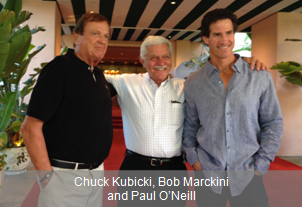
The excitement doesn't stop there. Chuck and Paul suggested we bring our golf clubs along and play golf at Kenwood Country Club in Cincinnati, probably the finest golf course in Ohio, and"are you ready for this"Riviera Country Club in Los Angeles.
Riviera Country Club, ranked as one of the best and toughest in the world, has hosted the U.S. Open, PGA Championships, the U.S. Senior Open and many other notable tournaments. Golf legends Ben Hogan, Byron Nelson, Sam Snead, Ken Venturi, Tom Watson, Nick Faldo, Fred Couples, and Phil Mickelson played the course regularly, and most of them tasted victory there in major tournaments. Celebrities like Douglas Fairbanks, Mary Pickford, Charlie Chaplin, Dean Martin, and Humphrey Bogart have graced its fairways. The walls are covered with photos of the rich and famous. One of my favorites was a photo of a golf foursome, Dean Martin, Bob Hope, Jerry Lewis, and Bing Crosby. Imagine a couple of hackers like Kubicki and Marckini playing that course? I can't … but we did.
I won't reveal our scores, but I will tell you that Paul O'Neill consistently outdrove the golf pro who played with us, routinely hitting the ball off the tee 300 yards down the fairway. The only good news for me that day was the fact that my high score helped raise my handicap, putting me, once again, in contention to win a prize at the next Proton Charity Golf Tournament in Rancho Mirage in 2015. It was a memorable few days to say the least.
Proton therapy continues to garner a lot of attention in the press. More and more published studies are proving both the efficacy and superiority of proton therapy for treating prostate cancer as well as many other types of cancers. In this month's BOB Tales we report on two of these studies.
Next year, the University of Maryland will open its new proton treatment center. In a press release published this month, Dr. Minesh Mehta, from the University of Maryland, put the concept of proton therapy in excellent perspective when he referenced the Hippocratic Oath taken by all doctors. Regarding proton therapy, he said, "This really is quite possibly the most dynamic treatment approach holding radiation oncologists to the concept of 'primum non nocere, ' or 'first, do no harm. '" That's what proton therapy is all about.
This month's BOB Tales will both inform and entertain you. As always, we welcome your feedback and suggestions for improving the BOB Tales. Just sent an email to Deb Hickey at [email protected].
Bob Marckini
PS: Late breaking news: We have just learned of a new threat to reimbursement for prostate cancer proton therapy by a group of private insurers. We will need your help with a letter/email response. We will have to act quickly as the open comment period is very short. A separate email will be sent requesting your help on this. Please be on the lookout for this important message.
To print the BOB Tales newsletter or view the newsletter with a larger font size, click here for the PDF file.
in this issue
- Vision 2020 revealed
- Study: Proton therapy reduces secondary cancer risk
- Study: Disease-free survival with proton better than IMRT
- STDs and prostate cancer
- Vasectomies and prostate cancer
- Depression and prostate cancer
- Member celebrates 23-year proton anniversary
- Proton after failed surgery
- Foods dieticians would never eat
- Top 10 veggies and fruits
- Review of hottest new book on prostate cancer
- And much more …
membership

We have 7,153 members; we added 68 new members last month. We have members from all US states and 35 countries representing all operating proton centers in the U.S. as well as four proton centers in Europe and Asia.
news report
Proton Therapy Reduces Second Cancer Risk
It has long been known that when targeting a tumor volume, significantly less radiation is deposited on healthy tissue with protons than with any form of conventional photon "X-ray" radiation. Past studies conducted at MD Anderson and Massachusetts General Hospital "MGH" in Boston have reported this. Dr. C. Chung reported at ASTRO in 2007 that according to one study, "patients who received proton therapy alone "not mixed X-rays and protons" had no secondary malignancies." This was also reported in the Wall Street Journal on August 5, 2009.
Pediatric Patients
Just recently, MGH and Harvard Medical School performed a detailed evaluation of the second cancer risks for pediatric patients with brain or head-and-neck tumors. The results were reported in the Journal Phys. Med. Biol. 592883.
Radiation to healthy tissue is of particular concern with young children because they have many years to live and thus a longer timeframe in which to develop secondary cancers. So, precise delivery of radiation to the tumor volume with minimal collateral damage to healthy tissue is especially important with children.
Proton vs. IMRT and VMAT
The recent MGH/Harvard pediatric study found that "while all plans proved equally good target coverage, different modalities led to distinct dose distributions. Analysis of dose-volume histograms "DVH" showed that in general, protons irradiated smaller volumes of healthy tissue than IMRT and VMAT "volumetric-modulated arc therapy". Proton therapy was particularly superior at the lower-dose end of the DVH curves, with 1.5 to 4 times less soft tissue volume and 5 to 6.5 times less skull volume irradiated by protons relative to photons."
The research team next calculated the lifetime attributable risk "LAR""the excess likelihood over the baseline risk of developing a second malignancy. For all tissues treated the LAR was lowest for proton plans and highest for IMRT and VMAT.
Once Again, Proton Comes Out on Top
"The lifetime risk of bone cancer was, on average, 3.5 to 9.5 times larger for photons "X-rays" than for protons."
Doctors and physicists have long agreed that the only safe dose of radiation to healthy tissue is a zero dose. So, proton therapy, once again, offers a distinct advantage over even the most advanced forms of photon "X-ray" radiotherapy.
Whether the tumor is in the brain, head, neck, breast, lung, or prostate, proton therapy will deliver more of the dose to the tumor, and significantly less radiation to surrounding healthy tissue. This should be a major consideration when making a treatment decision.
Study Shows Significantly Improved Disease-free Survival and Tumor Control with Protons vs. IMRT
The journal, Lancet Oncology, reported last month on a new study by radiation oncologists at Mayo Clinic. The team compared the world's literature on outcomes of proton therapy in the treatment of cancers of the head, neck, and skull base versus outcomes with IMRT. Tthey reported that "proton beam therapy significantly improved disease-free survival and tumor control when compared to IMRT."
According to head researcher, Robert Foote, M.D., a radiation oncologist at Mayo clinic, "our findings suggest that the theoretical advantages of proton beam therapy may, in fact, be real."
When reviewing studies of nasal cavity and paranasal sinus tumors, they found disease-free survival to be significantly higher at five years for patients receiving proton therapy than for patients receiving IMRT.
Why should this research be of interest to BOB members?
Why would this research by the Mayo Clinic on head, neck, skull cancers, and the research by MGH/Harvard on pediatric secondary cancers be of interest to prostate cancer survivors? If protons do a much better job of destroying cancers in children without doing collateral damage and causing secondary cancers, then why wouldn't this be true when treating cancer in the prostate? And, if disease-free survival is better with protons and collateral damage to important body parts around the head, neck, and skull significantly lower, then why wouldn't this be true when treating the prostate, which is surrounded by critically important parts of the male anatomy?
Multiple prostate cancer proton patient surveys show the benefits of proton therapy over other forms of prostate cancer treatment.
Sexually Transmitted Diseases and Prostate Cancer
A new, systemic review of several studies, published in Cancer Epidemiology, suggests that men who have contracted any sexually transmitted disease in their lifetimes have an increased risk of prostate cancer. The review, based on data from 47 studies published between 1971 and 2011, found men who have been infected with a sexually transmitted disease were at a 49 percent increased risk of being diagnosed with prostate cancer later in life, compared with those who never contracted a sexually transmitted disease.
Testosterone Levels
Whether or not sexually transmitted diseases contribute to an increase in prostate cancer, high testosterone levels, which are more likely found in men who have multiple partners, are known to increase men's risk of prostate cancer.
Vasectomies and Prostate Cancer
A 24-year follow-up study published in the Journal of Clinical Oncology shows that men who have undergone a vasectomy have had a modest increase in the incidence of prostate cancer"particularly lethal prostate cancer. Of the men who had regular PSA screenings, the relative risk of lethal prostate cancer increased by 56 percent in those who had had a vasectomy. Vasectomies were not associated with a higher risk of either low-grade or localized prostate cancer.
A history of a vasectomy was associated with a 10 percent increase in prostate cancer overall, and relative risk was 22 percent higher for high-grade prostate cancer "defined as prostate cancer with a Gleason score between 8 and 10".
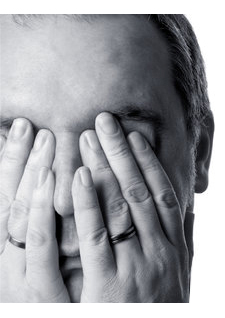
Depression and Prostate Cancer
According to a study published last month in the Journal of Clinical Oncology, depressed men with a diagnosis of intermediate- or high-risk prostate cancer, have worse overall outcomes. Of the 41,275 men diagnosed with clinically localized prostate cancer from 2004 to 2007, 1,894 were identified with a depressive disorder in the two years before the prostate cancer diagnosis.
Men with depressive disorder were more likely to undergo expectant management "active surveillance" for low-, intermediate-, and high-risk disease, in adjusted analysis. Depressed men were less likely to undergo definitive therapy "surgery or radiation" across all risk strata. Depressed men with low-, intermediate-, and high-risk disease were 16 percent, 25 percent and 86 percent more likely to die than non-depressed men.
events
LLUH Vision 2020 Unveiled, July 15, 2014
Imagine a new tomorrow where children play and thrive; people live longer and happier; good health is global; lives are restored; and being well means wholeness in body, mind, and spirit. Loma Linda University Health "LLUH" feels that now is the time to take a monumental step forward to a more comprehensive strategy, to build on their foundations of education, research, clinical care, wholeness, and service. They believe that when we go beyond health to wholeness, we are free to explore, to create, to invent and to help others.

According to LLUH President, Dr. Richard Hart, "We have always had a different approach to health care and education. Each day we seek more than to heal"we strive to transform lives. It is in wholeness that true human potential is unlocked."
Attendance
The event of July 15 was attended by more than 2,200 people, including representatives of six newspapers, four TV stations, a magazine and a radio station. There were also numerous local, state, and federal representatives on hand for the project's unveiling.
Vision 2020
Vision 2020 is the largest initiative in the history of Loma Linda University Health. It is a daring $1.2 billion strategy to build on the core strengths of LLUH, to pursue new discoveries and develop strategies for a healthier and whole world. Vision 2020 will combine the latest research and best health care practices with comprehensive prevention and wellness.
Some Specifics
Through Vision 2020, LLUH will:
- Advance its distinctive whole-person care with two new state-of-the-art hospitals for adults and children, including a 276-bed adult medical center with 96 intensive care beds and 180 medical-surgical beds.
- Construct a new Children's Tower expanding to 359 the number of beds, and will include 100 neonatal intensive care units, 115 pediatric intensive care units, 96 medical surgical and 48 units for the TotalCare Birth Center, making it one of the largest neonatal intensive care units in the United States.
- Multiply its impact on the world by strengthening its health sciences programs to produce top health care professionals who live and promote wholeness.
- Intensify efforts to improve human longevity and quality of life in its quest to save lives and discover new treatments for diseases and injuries.
- Build a new Wholeness Institute that will serve as a brain trust, exploring all aspects of what it means to live a whole life.
- Construct and create a building that houses discovery, research and the Wholeness Institute.
Groundbreaking is expected in 2015.
Excerpts from Dr. Hart's talk
Dr. Richard Hart was the keynote speaker at the event. Following is some of what he had to say:
"Our legacy is transforming the lives of the people we serve. Now is the time to be bold, to look toward what can be, and be daring."
"Through vision 2020 we will establish a new paradigm that begins with education, the foundation upon which Loma Linda University Health was built. Vision 2020 will allow us to expand our utilization of high-tech and high-touch in new and innovative ways, and provide scholarships and endowments to ensure we continue to attract the highest level of students and faculty. We will fully integrate healthy living and wholeness into every aspect of the student's life and training, and intensify our efforts to provide students with deeply meaningful service opportunities, providing hope and healing to those who are in the most desperate conditions around the world and here at home."
"At the heart of our vision for a healthier world is discovery. Our world-class researchers and students are continually working to improve the quality of life in our relentless quest to save lives and discover new treatments for disease and injury. Vision 2020 will create a collaborative work environment where these investigators can solve some of the most puzzling clinical challenges. In addition, we will establish the first academic-based Wholeness Institute. This institute will create intellectual synergy and generate new studies and discoveries on living whole, and educate health care professionals and community leaders."
"We will redefine what it means to be healthy. At Loma Linda University Health, we will do much more than impart knowledge, we will create it."
The Big Surprise
The big surprise came during Dr. Hart's talk. He introduced local businessman, Dennis Troesh, and his wife, Carol. They spoke about how many members of their family were treated at Loma Linda University Medical Center and how impressed they were with the care and compassion all family members received. Dennis noted that so many successful business men and women leave the Inland Empire after they make their money and take up residence in other parts of the state. But he and his wife decided to support the community in which they made their money. "Over the years, God has abundantly blessed our family, and it is our privilege and honor to give back to the community we have called home for most of our lives," said Carol.
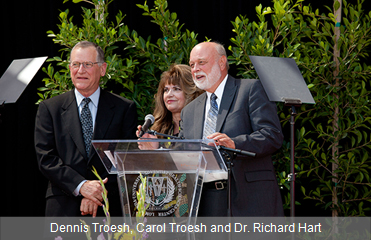
Next, 100 small children marched up to the stage, each holding a helium-filled balloon. And that's when Dr. Hart revealed the surprise. He noted that most of the 100 children had been treated and healed by the LLUMC Children's Hospital, that each child represented $1 million, and that Dennis and Carol have pledged $100 million to Vision 2020 to jumpstart the campaign. That brought all 2,000 plus attendees to their feet in applause.
Later in the evening, several others were recognized for making significant gifts toward the Vision 2020 campaign.
Other Gifts
Our good friend, BOB member Chuck Kubicki was visibly moved by the event. He and his wife, Mary, expressed their appreciation to Loma Linda by providing a very generous, seven-figure pledge toward Vision 2020. This is just one of many gifts given to LLUH by the Kubickis. To this day, 12 years after his treatment, Chuck talks about his time spent at Loma Linda as "the best experience of my life." And he speaks for the majority of patients treated at Loma Linda.
Another BOB member who was present at the event was Dr. Franklin House, who is a graduate of Loma Linda University. Franklin, a longtime supporter of LLUH, pledged a very generous $500,000 by establishing a life insurance policy to benefit Vision 2020.
Winston Churchill said, "We make a living by what we get; we make a life by what we give." The Troeshes, Kubickis, Houses, and many others, are truly helping to make lives whole through their generous support of Vision 2020.
A Great Start
Rachelle Bussell, Senior Vice President for Advancement at LLUH, expanded on the scope and magnitude of Vision 2020 and talked about various sources of funding. She noted that the private philanthropic goal for this $1.2 billion project is $350 million. Money from philanthropy will be used to fund clinical care, including hospital construction; education programs, including scholarships and faculty development; research and development of the new Wholeness Institute.
Rachelle noted that while we have a long way to go, we have made a great start. She said, "I am humbled to be able to announce, that as of today, more than $149 million has been pledged or given to Vision 2020."
Watch the Vision 2020 Videos
Watch several highlight videos of the events of July 15. You can watch a 7-minute highlight video, "Vision 2020 Highlights," or you can watch a recording of the one-hour live broadcast of the events described above, "Vision 2020"Full Event"7/15/14."
Side Note
One of the speakers at the evening event was Detective Alex Collins from the San Bernardino County Sheriff's Department. Alex's life was saved by LLUMC after he had been shot several times in the face, arm, chest, and leg while on duty in February, 2013. His partner was killed in the shootout. Alex was airlifted to LLUMC where "they gave me my life back," he said. His life was very much in danger. If he survived, he wasn't expected to be able to walk again or return to work. He proved everybody wrong. Alex is now back to work and walking just fine. Alex sat with us at dinner that evening. He's a big fan of the New York Yankees and Paul O'Neill, and is now the proud owner of a Paul O'Neill autographed Yankees baseball hat. Watch a video of Alex's story here.
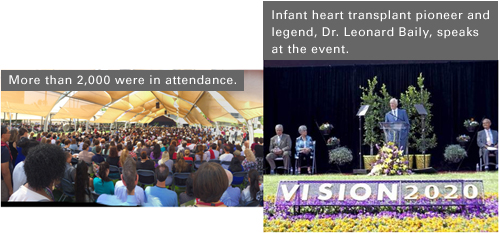

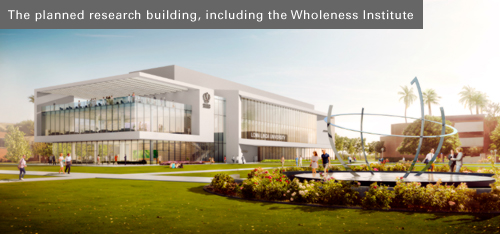
spotlight on members
Member Celebrates 23-Year Proton Anniversary
Harold Rabin was treated with proton therapy for his prostate cancer at Loma Linda University Medical Center in early 1991. He has been doing well ever since. In fact, he just celebrated his 93rd birthday!
In 1990, Harold had angioplasty following a heart attack. Two months later he was diagnosed with prostate cancer. His urologist, who favored surgery, expressed some concern about the trauma of a radical prostatectomy. This prompted Harold to begin a search for an alternative treatment. He investigated cryosurgery, which was new at the time, and then spoke with a medical doctor doing research at the National Institutes of Health in Bethesda, MD. He said, "Go to Loma Linda. They are using protons to kill cancer, and this exciting technology works. Besides, one of my former colleagues at NIH is there now."
Harold was accepted for treatment in early 1991. He remembers telling his urologist about his choice to undergo proton therapy. His mood abruptly changed, according to Harold. "All of a sudden I wasn't ‘Harold' anymore. I was 'Mr. Rabin.'" And his next comment was, "Mr. Rabin, if you want to be in an experimental program, that's your business."
Harold commuted from his home in Palm Desert, 110 miles round trip each day for eight weeks"age 70 at the time. "And I had the most wonderful experience of my life," he recalls.
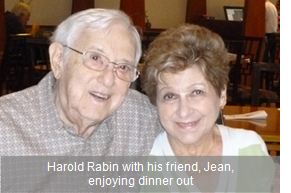
When asked about his recollections of Loma Linda 13 years ago, Harold noted that only one gantry was operating. The set-up and treatment took about a half hour. Also, "I left the hospital each day with magic marker marks all over my body." But most of all, he remembers, "the people there were the most pleasant, most wonderful, most gracious, and most professional I have ever met."
It took about four years for Harold's PSA to reach a nadir of 0.3, and there it has stayed for the past 23 years. To say Harold is happy with his results is an understatement. He remembers having a few episodes of rectal bleeding, but "that's been gone for years." And he has experienced no other side effects from his treatment.
Harold recently told us, "I still play golf, go to the gym regularly, and enjoy life with my wonderful lady friend, Jean. And, I am looking forward to many more years of active, cancer-free life."
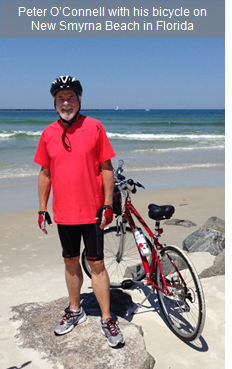
Proton after Failed Surgery: Member in "Better Shape"
Than Ever
In 2003, Peter O'Connell underwent surgery for his prostate cancer. Five years later, he had a recurrence. "I was frantic," Peter says, "especially because I was told that surgery was ‘the final cure!' I never expected to face it again …"
Peter was treated with proton therapy in 2008, five years after his failed surgery. Six years after his proton treatment, he is now 71 years old; weighs about the same as he did when he was 25; plays two hours of tennis, three days a week "Peter has participated in the Florida Senior Tennis Games for the past three years"men's doubles"; golfs one day a week; and spends the rest of his time riding his bicycle and enjoying life with his wife, Bonnie.
Peter tells us, "Heck, I am in better shape and condition now than when I was a 'young man! ' Thank you, proton!"
"Life after Proton" Stories and Proton Patient Testimonials
"Comforting to Prospective Patients
When anyone is diagnosed with an illness, they typically turn to the Internet before doing anything else. According to a report by Pew Research Center, 80 percent of Internet users, or about 93 million Americans, search for health information online and the number of people turning to the Web to search for a diverse range of health-related subjects continues to grow. This means the majority of men who are newly diagnosed with prostate cancer are looking for information online, and perhaps, most importantly, hope.
Our "Life after Proton" stories and proton patient testimonials offer just that. Bob Marckini wrote in his book that it was former patient testimonials that helped to calm his fears and ultimately help him to make the decision to undergo proton therapy for his prostate cancer. Countless BOB members have told us that former patient stories were not only comforting; in addition to speaking with former patients, their stories were the deciding factor in making their treatment decision.
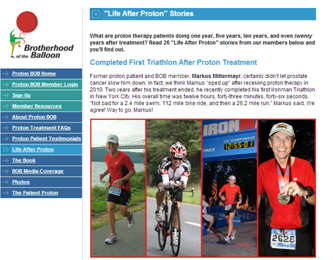
Prospective proton patients comment on the Life after Proton stories more and more, and they are surprised and excited by what they read and see. We also post many of these on our Facebook profile and receive some incredible comments. And as always, full testimonials detailing diagnoses, research, experiences with proton therapy, and life after treatment continue to be a huge driving force for our organization and proton therapy.
If you feel that proton therapy saved your life and has preserved the quality of your life, and you'd like to give a newly diagnosed man some hope today, please send an email to [email protected].
making a difference by giving back
Saying 'Thank You' for the Gift of Proton Therapy
If you are like most other BOB members, you had an excellent experience of treatment; your PSA is dropping or has leveled off; and your quality of life is as good as, or better than, before treatment.
How would you like to show your appreciation to Dr. James Slater, Dr. Jerry Slater, and Loma Linda University Medical Center for the pioneering work they did to make your treatment possible? Or, would you like to find a way to express your appreciation for your membership in the Brotherhood of the Balloon, the services we provide, and the comprehensive newsletters you receive each month? If so, we have a suggestion.
In May 2013, Bob Marckini received a great honor when LLUH announced the establishment of the Robert J. Marckini Endowed Chair for Proton Therapy Research. The current level of funding for the chair is $2,025,000. To fully fund the chair, so that interest on the principal can pay for research, we must reach $5 million.
To date, the BOB has raised about $10.6 million in total "gifts and planned giving" for various philanthropic efforts at Loma Linda. Almost 40 percent of our members regularly contribute to proton research and we are very proud of this.
If you would like to say "thank you" to LLUMC for the gift of proton therapy"whether or not you were treated at LLUMC"and/or to the BOB, you can make a gift to the Marckini Chair. See below for the specifics.
Once again, as Winston Churchill said, "We make a living by what we get; we make a life by what we give."
Matching Gift Promises to Double Yours
Don't forget: The founder of the Sequoia Foundation for Achievement in Culture and Education is encouraging fellow BOB members to match a $25,000 challenge grant. The foundation will match gifts of $1,000 or more to the Robert J. Marckini Chair, up to a total of $25,000, until December 31, 2014. Please consider taking this opportunity to double the impact of your gift!
If you have questions about the various ways to support proton research efforts, please contact the Office of Philanthropy at LLUH at 909-558-3284 or send an email to Aaron Laudenslager at [email protected].
To donate by check, make it out to "LLUMC Proton," specify Robert J. Marckini Chair in the memo, and mail it to: Loma Linda University Medical Center, Office of Philanthropy, P.O. Box 2000, Loma Linda, CA 92354.
Or, donate online. Specify Robert J. Marckini Chair under "Designations." Both credit and debit cards are accepted.
For more information on how to support the James M. Slater, MD, Proton Treatment and Research Center through an estate gift, contact Todd Mekelburg at the Office of Planned Giving by phone at 909-558-4553, visit the website at llulegacy.org, or email [email protected] .
health
Food Dieticians Would Never Eat
Think you're being healthy by using fat-free dressing on your salad? Maybe you shouldn't. Below is a list of some of the food items dieticians have reported they would never eat, and while some of the responses are no-brainers, there are some surprises.
Sprouts
"Raw sprouts are one food I tend to avoid," said nutrition expert and registered dietitian Toby Amidor, author of The Greek Yogurt Kitchen. There have been at least 30 reported illness outbreaks associated with raw or lightly cooked sprouts from salmonella or E. coli bacteria.
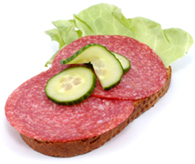
Processed Red Meat
There is link between processed red meat and cancer, heart disease and premature death. Registered dietitian and nutritionist Cara Anselmo tells her clients never to eat bacon, sausage, pepperoni and most hot dogs, "They're basically just salt, fat, and preservatives."
Processed Foods
Processed foods are our biggest nutrition issue, according to registered dietitian Jae Berman. "If we just ate foods where we knew the ingredients, understood what is in the food and were aware of where the food came from, we would be a healthier society," she said. She urges people to focus on whole, local, and seasonal foods.
Raw Milk
"Raw milk, whether it is from cows, sheep, or goats, has not been pasteurized to kill harmful bacteria," said registered dietitian Joan Salge Blake, clinical associate professor at Boston University and author of Nutrition & You. While some claim there are health benefits to drinking milk that is unpasteurized and unhomogenized, raw milk carries dangerous risks. Your best bet is to stick to organic milk, which is made from cows that aren't treated with growth hormones.
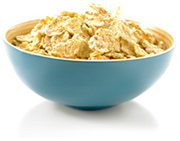
Cereals
Cereals with 4 grams of fiber or less are high in sugars and calories and less nutrient-dense than whole grains. "We have become consumers of food-like products, rather than whole foods," said registered dietitian Carol Ann Brannon.
Fat-free Bottled Salad Dressing
"Fat-free bottled salad dressing is never going to taste as good as your own vinaigrette, made with extra-virgin olive oil, and it has a strange consistency due to the fillers used to thicken it to make up for the lack of fat," said registered dietitian Janet Helm, author of The Food Lover's Healthy Habits Cookbook. Researchers at Purdue found that fat-free or low fat salad dressings reduced the absorption of fat-soluble carotenoids"beneficial compounds in the salad such as lutein, lycopene, beta-carotene, and zeaxanthin. Your best bet is to make your own salad dressing.
Canned Soup
A regular sized can of Campbell's chicken noodle soup contains 2.5 servings, which breaks down to 150 calories, 5 grams of fat, 20 grams of carbohydrates, and a whopping 2,225 milligrams of sodium. "Watch the nutrition facts," said registered dietitian and nutritionist, Sara Lopinski, with the Division of Endocrinology at Southern Illinois School of Medicine. She recommends staying with the reduced sodium and fat versions and limiting yourself to the suggested serving size.
Click here for the original article.
Top 10 Veggies and Fruits
Top of the Veggie List
From a list of 10 of the most commonly consumed vegetables in the country, broccoli holds the top spot for having the most phytochemicals"compounds that protect against chronic diseases.
Bottom of the Veggie List
Cucumbers are described by some people as "water you can eat."
Runners-up
The 9 runners-up to broccoli are kale, Brussels sprouts, carrots, squash, sweet potato, eggplant, red peppers, spinach, and cabbage. Red peppers actually beat out broccoli in terms of having the highest levels of antioxidants.
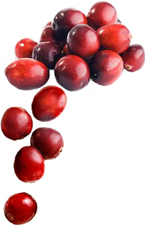
Top of the Fruit List
The same researchers rated 10 of the most popular fruits. Cranberries, with the most phytochemicals and antioxidants, topped the list.
Bottom of the Fruit List
Fruit juices you find at the supermarket aren't always what they seem"they may have small amounts of real fruit in them, but chances are, they also contain artificial flavor and a lot of sugar.
Runners-up
The 9 runners-up to cranberries are apples, red grapes, strawberries, peaches, lemons, pears, bananas, oranges, and grapefruit.
NOTE: There is some debate out there about the most healthy vegetables and fruits. We found our information on RealAge.com.
Dog Days of Summer
Here is a list of some things you should keep in mind to stay safe this summer:
Take care of your skin.
Sunscreens with an SPF of 30 block about 97 percent of ultraviolet rays "anything higher than 30 blocks 97 to 98 percent". Choose a "broad-spectrum" sunscreen, meaning it protects against both UVB and UVA rays.
Not only is a sunburn painful, it is dangerous! Remember to reapply your sunscreen after sweating or swimming. It's also a good idea to wear a hat because your scalp can get sunburned, too.
Don't spend all day outside.
Limit your outdoor activities, especially between the hours of 10 a.m. and 2 p.m. If you must work in your garden, try to do it early in the morning or in the early evening when the sun is not as strong.
Keep cool.
Wear light-colored clothes of breathable material. Dark clothes and synthetics trap heat.
Stay hydrated.
Drink water. Caffeine and alcohol may taste good, but they actually dehydrate you. Always keep a bottle or two of water with you.
Protect your house.
Pull down your shades or close your drapes wherever the sun comes in. This will help to keep your home cooler and your A/C won't have to work as hard! This also protects colored fabrics "sofa, rugs" from fading.
Pets are important, too.
Make sure your pets are not left outside, or in a hot car. Be sure to keep them hydrated, and do not cut or shave your pet without consulting your vet first. Some pets have very light skin and can get a sunburn or heat stroke. A coat of fur actually keeps them insulated from the sun!
Wear bug spray.
When outdoors, make sure you have a bug repellent on and be sure to reapply often. Mosquito and tick bites can cause a number or serious illnesses in both humans and pets. If a bite has serious signs and symptoms such as fever, headache, and body aches, contact your doctor "or vet" immediately!
Series: Top 20 Most Common Health Questions "and Answers"
Last month, we began a series on the top 20 most common health questions "and answers" from Business Insider Magazine. Here are the second two::
Do cough syrups work?
Short answer: No. In 2006, the nation's chest physicians agreed that the majority of over-the-counter cough medicines don't actually work. These colorful syrups typically contain doses of codeine and dextromethorphan that are too small to be effective.
Only cough suppressants that contain older antihistamines seem to relieve coughs. That includes brompheniramine.
Does sugar cause hyperactivity?
Short answer: No. Following a review of 23 studies, a 1996 report published in the Journal of the American Medical Association concluded that sugar "does not affect the behavior or cognitive performance of children."
The age-old myth that kids misbehave when they eat large amounts of candy, cookies, and other junk food, could be related to the type of events where these foods are typically served. For example, kids are more wound-up at birthday parties and during Halloween when sweet treats tend to flow freely.
the book
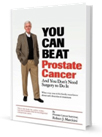
We have 195 reader reviews on Amazon"more than any other book in the top 50! Here is an excerpt from what one reader recently had to say:

Great book on prostate cancer written by a patient … "bear
I read this book for a dear friend of mine who was experiencing a rapid increase in PSA. We were both worried sick. In need for information, I turned to Amazon. Bob's book caught my eye. I saw a lot of favorable reviews, so I bought it immediately. I'm glad I did.
The book left me hopeful; it made me understand that prostate cancer need not be a death sentence; and, I learned, if caught early and treated with the right therapy, it can be curable.
I recommended the book to my friend, and relayed the key messages of the book to him.
Did you find Bob's book helpful?
Please help us to spread the word and educate others about proton therapy. If you found Bob's book to be helpful in making your proton treatment decision, please post a review on Amazon.
Once you are logged into your Amazon account, click here and click the "Create your own review" button. NOTE: Reviews can be just a few sentences"it only takes a few minutes. And, don't forget to rate the book from 1 to 5 stars!
Don't have an Amazon account? No problem. Sign up here"it's free.
Available in Amazon's Kindle format, Barnes & Noble's NOOK Book, and Apple iBook format
Buy the Kindle version now for $9.99.
Don't have a Kindle? No problem"just download the free Kindle reading software for your smart phone or tablet.
Buy the NOOK Book version now for $9.99.
Don’t have a NOOK? No problem. Just download the free NOOK reading app for your Android smart phone, tablet, or iDevice.
Buy the book from the iTunes store for $9.99 for your iPhone, iPad, or iPod Touch in iBook format.
The hard copy version of You Can Beat Prostate Cancer is available online at Amazon, Barnes & Noble and LuLu Press.
Proceeds from book sales are used to help fund BOB efforts and to support proton therapy research.
Ask about our bulk discount for hard copy books for anyone interested in spreading the word about proton therapy: [email protected]
odds & ends
Excellent Book on Prostate Cancer
A Note from Bob Marckini: This summer I read a terrific new book on prostate cancer. I learned about it when this book showed up as the most popular book on prostate cancer on Amazon. It briefly pushed my book from the #3 to the #4 position. So, I purchased the book, read it, and loved it. I was most impressed with the author's treatment of new developments in imaging that can help identify tumor location, both for biopsies and focal treatment. I recommended the book to my friend, BOB member, Dr. Pat Greany, who felt the same way after reading it. I then asked Pat if he would write a review of the book for the BOB Tales and here it is:
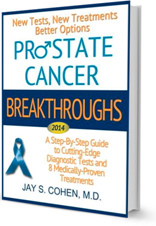
Prostate Cancer Breakthroughs 2014,
by Jay Cohen, M.D.
The book is a description of the process the author went through in making a decision as to which treatment, if any, he would pursue after being diagnosed with prostate cancer. It is an excellent resource for men who are confronted with a similar situation as it provides a wealth of information they likely will not obtain from their primary care physician, urologist, or even urologic surgeon or radiation oncologist.
Section 1, on "Obtaining a Thorough Diagnostic Evaluation," includes a description of some of the most advanced diagnostic procedures, including multiparametric MRI and C-11 choline PET/CT scans, which help to precisely locate tumors within the prostate and beyond, and may also be used for "targeted" biopsies, which may allow for focal treatments. Dr. Cohen also gives considerable attention to color Doppler ultrasound, an advancement over traditional ultrasound technology, allowing tumors to be visualized to a greater degree than by the traditional transrectal ultrasound "TRUS" approach.
Despite his intent to present a comprehensive array of the most up-to-date diagnostic technologies, there were a few weaknesses or omissions:
- Although Dr. Cohen mentions both the C-11 acetate PET/CT scan and the C-11 choline PET/CT scan, he didn't distinguish adequately between C-11 acetate and C-11 choline, which is prostate cancer specific and is FDA and Medicare-approved for recurrent PCa.
- A scan he failed to mention altogether is the sodium fluoride F-18 bone scan, which is superior to the traditional bone scan using another tracer.
- Similarly, he failed to mention the Feraheme MRI, which is used to detect prostate tumor cells in pelvic lymph nodes.
In Section 2, Dr. Cohen discusses most currently-available treatment options and partitions them into "Aggressive" therapies "prostatectomy, radiation", "Focal" therapies "cryotherapy, focal laser ablation, high intensity focal ultrasound "HIFU"" and "Non-invasive" therapies "androgen deprivation [ADT] and chemotherapy". He rightfully cautions the reader about the hazards of prostatectomy, including advanced robotic procedures. He also presents precautionary information about all forms of radiation.
On p. 109, Cohen reports the following outcomes from surgery and IMRT: "Surgery: 50 percent impotence and 8 percent incontinence, which are often permanent; all the other adverse effects and risks of the surgery and return of cancer in 25 percent. Radiation IMRT: 35 percent impotence, 2 percent rectal burn, 2 percent urethral inflammation, and return of cancer in 25-30 percent." His discussion of proton therapy, which he portrays as being more expensive, but no better than IMRT, is inadequate and inaccurate, citing a flawed study published in the J. Natl. Cancer Inst. that was based upon Medicare claims data, rather than clinical outcome data.
These results should be compared with those in a recent study performed at the University of Florida Proton Therapy Institute, published in the International Journal of Radiation Oncology. Five-year rates of biochemical and clinical freedom from disease progression were 99 percent, 99 percent and 76 percent in low-, intermediate-, and high-risk patients, respectively. GI and urologic toxicity were 1 percent and 5.4 percent, respectively. They concluded that "Five-year clinical outcomes with image-guided proton therapy included extremely high efficacy, minimal physician-assessed toxicity, and excellent patient-reported outcomes."
Finally, the author focuses on active surveillance and describes why he chose that as his preferred option, rather than pursuing a more aggressive treatment.
Dr. Cohen may want to reconsider the virtues of proton therapy, which offers an unequalled success rate and exceptionally low morbidity rate, especially since he lives in close proximity to Loma Linda University.
The Beauty of Pollination
This is one of the most beautiful videos you will ever see "4 ½ minutes". It is time-lapse, as well as high-speed photography, both speeding up and slowing down what goes on in nature. Watch the hummingbird doing rolls chasing a bee. If you don't know what goes on in the garden when you aren't paying attention, watch this.
Series: Messing with Your Mind
Here's the fourth in a series of five optical illusions that really mess with your mind. The center beam disappears. Look from left to right.

on the lighter side
Last Month's Brain Teaser/Riddle
Pronounced as one letter, and written with three; two letters there are, and two only in me. I'm double, I'm single, and I'm black, blue and gray; I'm read from both ends and the same either way.
What am I?
Answer: An eye. Last month's winner wishes to remain anonymous "he received a copy of the signed book".
New Brain Teaser/Riddle
What 5-letter word becomes shorter when you add two letters to it?
Answer next month: The first to send an email to [email protected] with the correct answer will receive a signed copy of Bob's book. No cheating by using the Internet!
Walking on the Grass
The room was full of pregnant women with their husbands.
The instructor said, "Ladies, remember that exercise is good for you. Walking is especially beneficial. It strengthens the pelvic muscles and will make delivery that much easier. Just pace yourself, make plenty of stops and try to stay on a soft surface like grass or a path."
"Gentlemen, remember you're in this together. It wouldn't hurt you to go walking with her. In fact, that shared experience would be good for you both."
The room suddenly became very quiet as the men absorbed this information. After a few moments a man, name unknown, at the back of the room, slowly raised his hand.
"Yes?" said the instructor.
"I was just wondering if it would be all right if she carries a golf bag while we walk?"
Brings a tear to your eye, doesn't it? This level of sensitivity can't be taught.
Women's Revenge
"Cash, check, or charge?" I asked, after folding items the woman wished to purchase.
As she fumbled for her wallet, I noticed a remote control for a television set in her purse.
"So, do you always carry your TV remote?" I asked.
"No," she replied, "but my husband refused to come shopping with me, and I figured this was the most evil thing I could do to him legally."
Quote of the Month
"Life is not the way it's supposed to be. It's the way it is.
The way we cope with it is what makes the difference."
"Virginia Satir
final thought
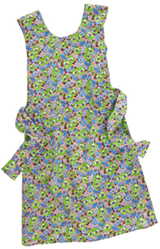
Aprons
I don't think our kids know what an apron is. The principle use of Grandma's apron was to protect the dress underneath because she only had a couple. It was also because it was easier to wash aprons than dresses, and aprons used less material. But along with that, it served as a potholder for removing hot pans from the oven.
It was wonderful for drying children's tears, and on occasion was even for cleaning out dirty ears.
From the chicken coop, the apron was used for carrying eggs, fussy chicks, sometimes half-hatched eggs to be finished in the warming oven. When company came, those aprons were ideal hiding places for shy kids. And when the weather was cold, Grandma wrapped it around her arms.
Those big old aprons wiped many a perspiring brow, bent over the hot wood stove. Chips and kindling wood were brought into the kitchen in that apron.
From the garden, it carried all sorts of vegetables. After the peas had been shelled, it carried out the hulls. In the fall, the apron was used to bring in apples that had fallen from the trees.
When unexpected company drove up the road, it was surprising how much furniture that old apron could dust in a matter of seconds. When dinner was ready, Grandma walked out onto the porch, waved her apron, and the men folk knew it was time to come in from the fields to dinner.
It will be a long time before someone invents something that will replace that "old-time apron" that served so many purposes.
REMEMBER: Grandma used to set her hot baked apple pies on the window sill to cool. Her granddaughters set theirs on the window sill to thaw.
They would go crazy now trying to figure out how many germs were on that apron.
I don't think I ever caught anything from an apron"but love …
Low PSAs to all,
Bob Marckini and Deb Hickey
You can download this month's BOB Tales in PDF format to your computer by "right-clicking" ("control-clicking" on Mac) and going to the "Save Target As… " option on the menu that pops up.
NO MEDICAL ADVICE: Material appearing here represents opinions offered by non-medically-trained laypersons. Comments shown here should NEVER be interpreted as specific medical advice and must be used only as background information when consulting with a qualified medical professional.

